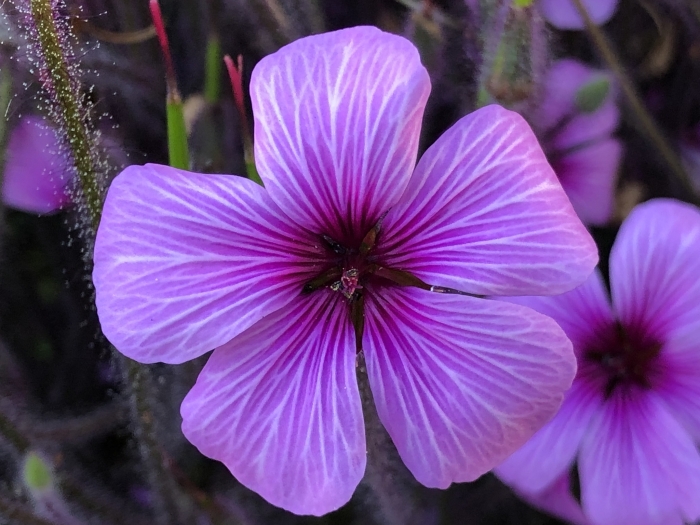Madeira Cranesbill
(Geranium maderense)
Madeira Cranesbill (Geranium maderense)
/
/

Al Kordesch
Public Domain
Image By:
Al Kordesch
Recorded By:
Copyright:
Public Domain
Copyright Notice:
Photo by: Al Kordesch | License Type: Public Domain | License URL: http://creativecommons.org/publicdomain/zero/1.0/ | Rights Holder: Al Kordesch | Publisher: iNaturalist | Date Created: 2019-05-04T02:17:30Z |






























Estimated Native Range
Summary
Geranium maderense, commonly known as Madeira Cranesbill, is a biennial herb native to the subtropical Laurisilva forests of Madeira, an environment characterized by high humidity and mild temperatures. This plant can reach a height and width of 120–150 cm (47–59 in), forming a large, mound-like shape with deeply divided, fern-like leaves that add a textural element to the garden. The flowers are spectacular, with large panicles of magenta or pink blossoms atop hairy red stems, blooming profusely in late spring to early summer. The flowers are highly ornamental and attract pollinators such as bees and butterflies.
Madeira Cranesbill is valued for its large, showy flower clusters and its lush foliage, which can provide a tropical feel to temperate gardens. It is suitable for border planting, as a specimen plant, or in a cottage garden setting. While it can tolerate a range of light conditions from full sun to full shade, it thrives best in part shade. It requires well-drained soil and consistent moisture, but is not drought-tolerant. It is hardy in mild or coastal areas down to −5 °C (23 °F) and has received the Royal Horticultural Society’s Award of Garden Merit for its outstanding qualities. However, it may be short-lived and is best propagated by seed to ensure continued presence in the garden.CC BY-SA 4.0
Madeira Cranesbill is valued for its large, showy flower clusters and its lush foliage, which can provide a tropical feel to temperate gardens. It is suitable for border planting, as a specimen plant, or in a cottage garden setting. While it can tolerate a range of light conditions from full sun to full shade, it thrives best in part shade. It requires well-drained soil and consistent moisture, but is not drought-tolerant. It is hardy in mild or coastal areas down to −5 °C (23 °F) and has received the Royal Horticultural Society’s Award of Garden Merit for its outstanding qualities. However, it may be short-lived and is best propagated by seed to ensure continued presence in the garden.CC BY-SA 4.0
Plant Description
- Plant Type: Herb
- Height: 4-5 feet
- Width: 3-5 feet
- Growth Rate: Moderate
- Flower Color: Pink, Purple
- Flowering Season: Spring, Summer
- Leaf Retention: Evergreen
Growth Requirements
- Sun: Full Sun, Part Shade
- Water: Medium
- Drainage: Fast
Common Uses
Bee Garden, Bird Garden, Butterfly Garden, Deer Resistant, Drought Tolerant, Fragrant, Low Maintenance, Rabbit Resistant, Showy Flowers
Natural Habitat
Native to the subtropical Laurisilva forests of Madeira
Other Names
Common Names: Giant Herb-Robert, Madeira Storchschnabel, Pássaras, Madeiranäva
Scientific Names: , Geranium maderense,
GBIF Accepted Name: Geranium maderense Yeo